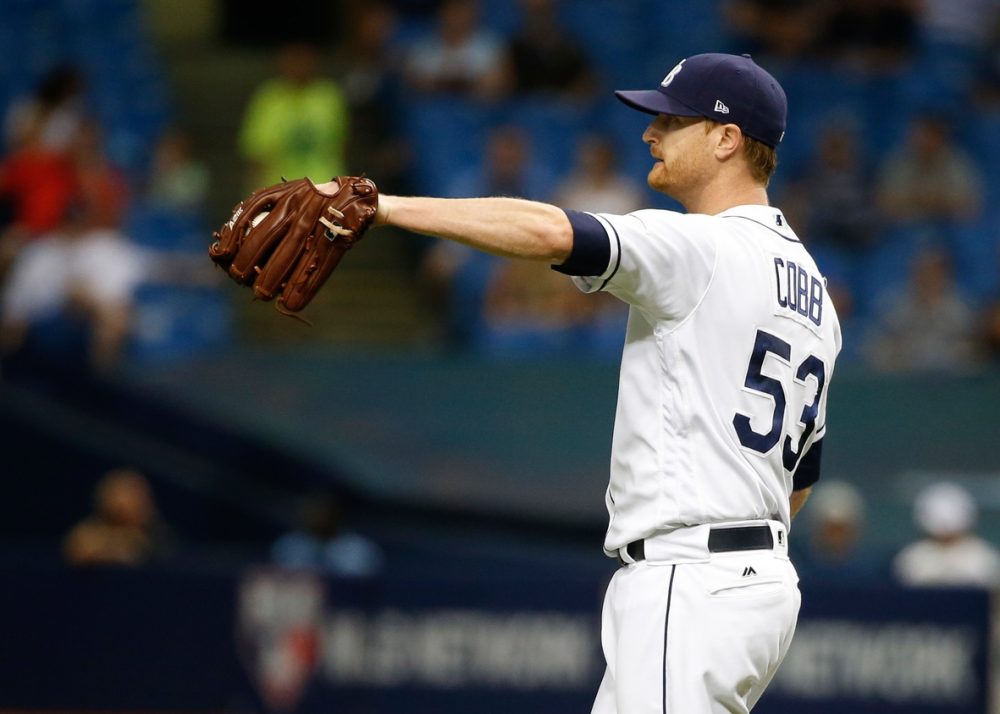
Baltimore Orioles signed RHP Alex Cobb to a four-year, $57 million contract. [3/21]
Four years and $57 million for Alex Cobb would be a normal, ordinary signing in any other offseason. In fact, it might even be a little light. Two offseasons ago, Mike Leake and Ian Kennedy signed five-year deals worth $80 million and $70 million. Three offseasons ago, Brandon McCarthy signed a four-year, $48 million deal. Four offseasons ago, Matt Garza, Ricky Nolasco, and Ubaldo Jimenez signed four-year deals worth $50 million, $49 million, and $48 million. You get the idea.
Regardless of what you think of Cobb specifically, free agent pitchers like him—right-handed, around 30 years old, track record of a mid-rotation starter—have generally gotten contracts worth $12-15 million per year over four or five years. And yet within the context of this offseason, Cobb’s deal with the Orioles stands out as atypical, in length, in cost, and in timing. Just two weeks earlier another branch on the Leake/Kennedy/McCarthy/Garza/Nolasco/Jimenez tree, Lance Lynn, settled for a one-year, $12 million deal with the Twins.
- Lynn is 31 years old, with a career 3.38 ERA and 114 ERA+ in 978 innings, including a 3.43 ERA and 124 ERA+ in 186 innings last season after missing all of 2016 following elbow surgery.
- Cobb is 30 years old, with a career 3.50 ERA and 111 ERA+ in 700 innings, including a 3.66 ERA and 113 ERA+ in 179 innings last season after missing all of 2015 and most of 2016 following elbow surgery.
Given the history of similar free agents, it would have made sense if Lynn and Cobb both signed four-year deals worth around $60 million. And given how slow and depressed this offseason has been, it also would have made sense if Lynn and Cobb both signed one-year deals worth around $12 million. What doesn’t make sense, to me at least, is Lynn signing for $12 million and Cobb signing for $57 million. (Baltimore also had to foreit a higher draft pick than Minnesota—51st vs. 96th overall—but if you’re giving up a top-100 pick there’s an argument to be made that it’s better to do so for more than a one-year fix.)
Why was Cobb worth four times as many years and nearly five times as much money, just two weeks later? For one thing, Lynn reportedly turned down a multi-year offer from the Twins, instead choosing to take a one-year deal and re-enter free agency another season removed from surgery and in what almost has to be a better market. Cobb pushed for a long-term deal, choosing to take his payday now, even if it’s less than it would have been in a typical offseason. Both choices have merit, certainly, and generally speaking it’s tough to really blame anyone, in any situation, for taking $57 million. And yet Lynn’s one-year deal is still worth less per season than Cobb’s four-year deal.
It’s also possible that Lynn signing provided Cobb with some added leverage in that he was the only viable impact starter left on the market. For a team like the Orioles, who clearly need all the pitching help they can get, it was Cobb or bust at this point in the offseason. In fact, they waited so long to sign him that Cobb is expected to begin the season in the minors, building up his arm strength to join the big-league rotation in mid-April. Cobb was running out of options, but so were pitching-starved teams like the Orioles, and ultimately Cobb is the one with the talent that’s in demand.
There’s an even easier potential explanation: The Orioles (and perhaps other teams, too) simply think Cobb is a lot better than Lynn.
I viewed them similarly coming into the offseason and most free agent rankings—including BP’s own—agreed, slotting Cobb and Lynn (or Lynn and Cobb) in as the third- and fourth-best available starters behind Yu Darvish and Jake Arrieta. There are sound reasons to prefer one over the other, and perhaps even strong reasons, but … well, $57 million is a lot different than $12 million. PECOTA isn’t high on either pitcher for 2018, projecting Cobb for a 4.92 ERA with Orioles and Lynn for a 4.68 ERA with the Twins. Those would be career-worst marks for each, and more than a run worse than their respective career ERAs, but a) the projection system is leery of pitchers who recently missed entire seasons, and b) they both saw their secondary numbers get considerably worse last year.
Last month, Matthew Trueblood wrote an excellent, in-depth analysis of Cobb and why PECOTA projected him so poorly for 2018. It’s a must-read for Orioles fans, but the short version is that Cobb lacks of a standout third pitch, struggled to generate strikeouts and ground balls in his first full season back from elbow surgery, and has an uninspiring list of same-age comparable players. Of course, all of that goes out the window if Cobb can get closer to his pre-2015 self the further his surgery disappears in the rear-view mirror.
I’m willing to believe that 2017 does not represent the post-surgery ceiling for Cobb, who fared very well in BP’s all-encompassing pitching metric, Deserved Run Average, from 2011-2014. If he can get back to being, say, a consistent 3.75 ERA pitcher (with the secondary numbers to match), the Orioles will have gotten a tremendous last-minute bargain despite paying what is a relative premium within this weird offseason. And even if Cobb is more of a 4.50 ERA pitcher going forward, he’d still be worth roughly what the Orioles gave him, particularly considering Baltimore’s longstanding, constant need for short- and long-term rotation help.
Thank you for reading
This is a free article. If you enjoyed it, consider subscribing to Baseball Prospectus. Subscriptions support ongoing public baseball research and analysis in an increasingly proprietary environment.
Subscribe now